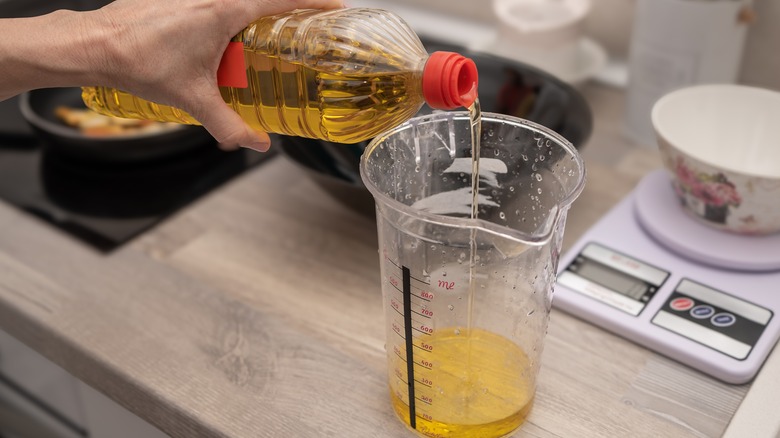The Best Way To Measure Liquid Ingredients For Baking Involves A Mini Workout
If we were to tell you that the best way to measure liquid ingredients for baking involves a mini workout, you might consider us a couple of sandwiches short of a picnic. But hear us out; we aren't suggesting that you start doing jumping jacks on the kitchen floor. Rather, you need to master the art of the perfect squat so your eyes are at counter level and better placed to gauge the amount of oil, buttermilk, or melted butter in your measuring jug.
While you could lift your jug up to check whether you've poured in the correct quantity of milk, you'll likely be unable to keep your hand perfectly steady on the handle. This causes the liquid inside to slosh around, preventing it from reaching an equilibrium and remaining steady, which leaves you trying to pin down a moving target. Also, you can't tell how much liquid is in a vessel from above so you need to alter your stance. It's best to place your jug on a hard, level surface, such as your kitchen counter, and move your body down into a squat position so you can clearly see the markings on the front. The liquid will settle into a straight line with a very mild curve (known as a meniscus) as it meets the sides of the vessel it's been decanted into. Then you can properly check that you've precisely measured the perfect amount of beaten eggs, water, or yogurt for your bakes.
Too much liquid can impact the outcome of your bakes
It isn't the end of the world if you accidentally add a splash more milk to a cake recipe, however, it will have an effect on the final result. For example, adding too much liquid to a cake can elicit a texture that's closer to a muffin. Conversely, using too little liquid will make your batter overly thick and possibly cause it to crack as it bakes, resulting in an unpalatably dry crumb. Messing with the ratio of wet to dry ingredients hampers the quality of baked goods because they need to be exact, unlike the recipes for dishes like stews and casseroles where there's plenty of bandwidth to safely experiment. While you could safely swap milk for water at a 1:1 ratio in a baking recipe, you don't want to accidentally increase or lower the volume noticeably. Also bear in mind that you need to have the right proportion of liquid to activate leavening agents, like baking soda, baking powder, and yeast.
Always try to measure your liquid ingredients in a transparent vessel rather than in metal measuring cups that you can't see through. This makes it easier to estimate smaller measures of ingredients that are used sparingly, such as alcohol or liquid flavorings. These clear plastic measuring cups sold on Amazon are awesome because you can use them to measure full cups and all the way down to ⅛ of a cup.

